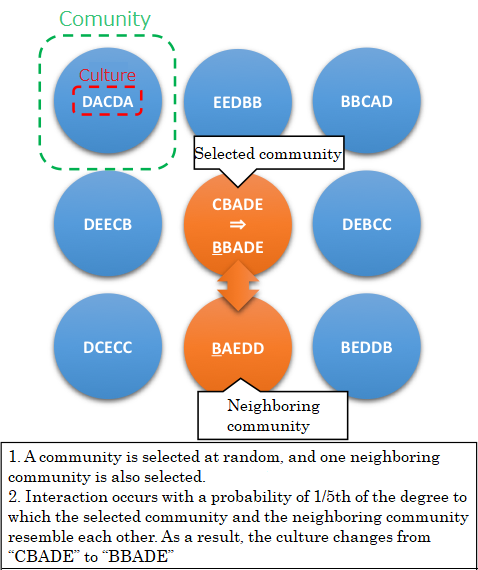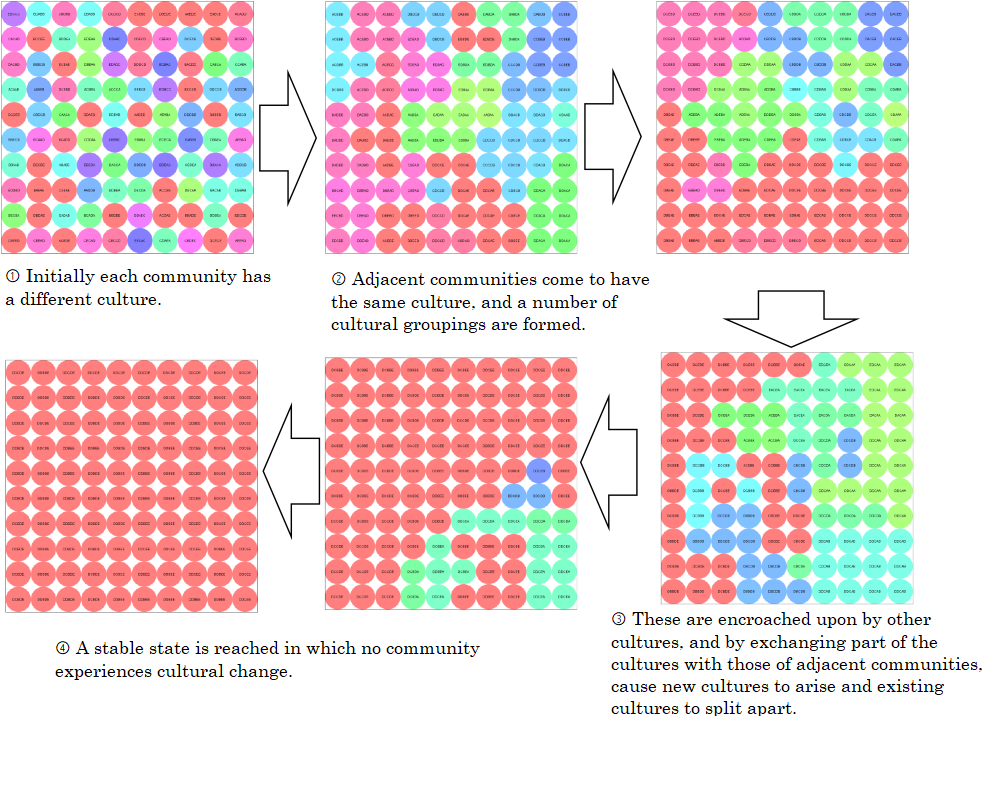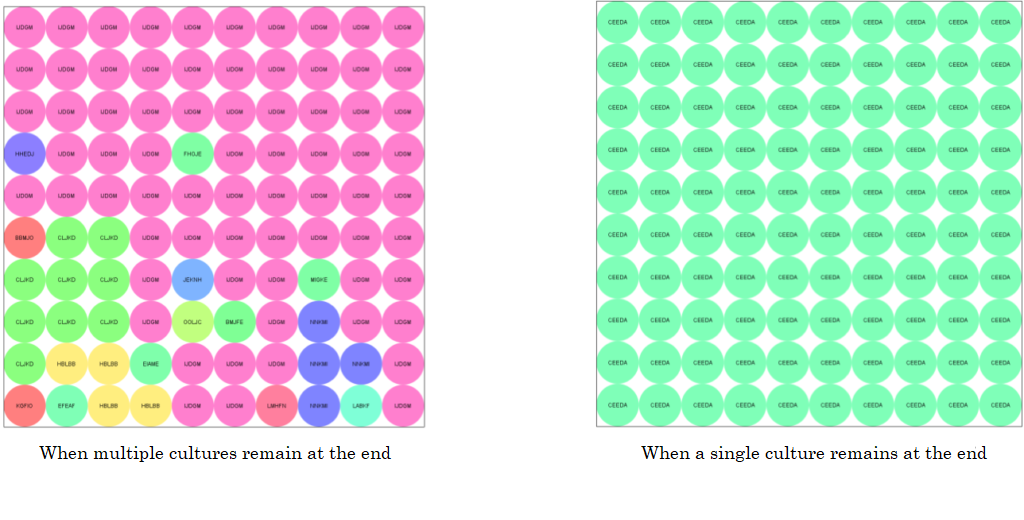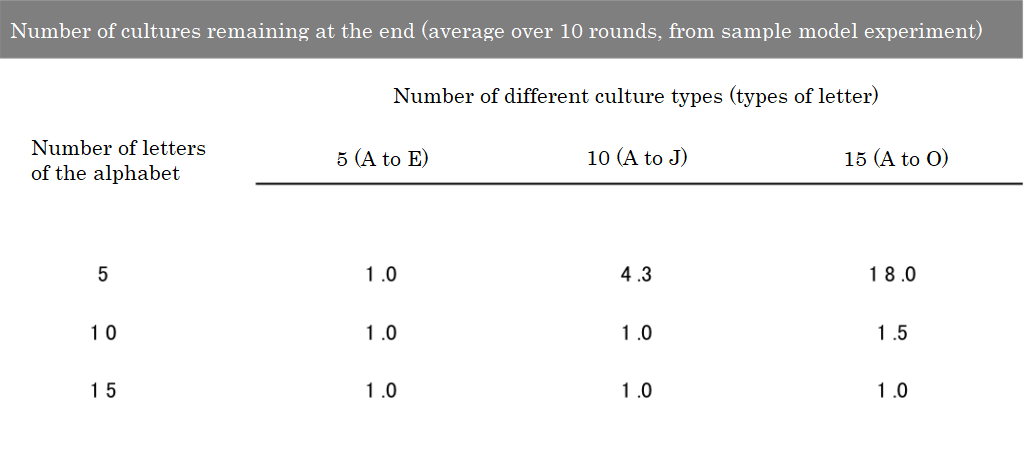MAS models
Axelrod’s dissemination of culture model
What is Axelrod’s dissemination of culture model?
A model that reproduces the dissemination of culture model announced in 1997 by American political scientist Robert Axelrod. This model differs from previous models of cultural dissemination in that it posits that culture can be expressed through combinations of multiple attributes such as language, religion, technology, style of clothing, and so on. Within a given society, various cultural communities (such as villages and regions) coexist, and the culture of a certain community will change in proportion to the degree to which it resembles that of a neighboring community, so that it comes to resemble the neighboring community more closely, in a process described as cultural dissemination.
The expression of culture within the model
Culture is expressed by combining multiple attributes such as language, religion, technology, style of clothing and so on, in the form of letters of the alphabet. In the example figure, CBADE and BAEDD are instances of this.
For example, if we take the first character to represent the attribute for language, different languages can be expressed by representations such as “C: Spanish” and “B: English.” In the same way, if we take the second character to represent the attribute for religion, it means that different religions can be expressed by representations such as “B: Islam” and “A: Christianity.” The following characters are used in the same way for constituent attributes of the culture. For example, if the strings for two communities are compared and the second character is found to be identical, it means that they share the cultural attribute corresponding to the second character. This also means that the greater the number of identical characters, the greater the resemblance between the two cultures, whereas when all the characters are different, it indicates that the cultures are completely dissimilar.

Model rules
If two communities have the strings “CBADE” and “BAEDD” respectively, both communities share the letter “D” as the fourth character (for example, let us suppose that for the attribute style of clothing, this represents “D: Western”), so they share part of their culture, actually 1/5th of their culture because they share one attribute out of five.
Then the following two steps are repeated many times.
①One community from the total is selected at random, and one neighboring community is also selected.
②With a probability equal to that of the resemblance between the cultures (for example, 1/5th), one attribute (character location) of the selected community and the neighboring community is chosen at random and the attribute (character) of the selected community is changed to match the attribute (character) of the neighboring community.
Registration with artisoc Cloud is required to run the model.
Model highlights
We performed the experiment repeatedly in accordance with the above-mentioned rules. In order to make it easier to understand, communities with the same culture (character string) are represented in the same color. As the model cycles through the steps, you can confirm the change in the color of the communities (culture). Incidentally, you can see that the communities in which the color (culture) changes are those communities in contact with different colors (cultures). When these changes are viewed as a whole, the cultures unify or split apart in a cyclical repetition.
For example, even in a single experiment, as communities that were initially a collection of diverse cultures (refer to 1 in the Figure) steps through the cycle, the cultures of adjacent communities begin to resemble each other, allowing us to confirm that they have unified to form cultural groups (refer to Figure 2).
As we go further into the cycle, within those cultures that were unifying to form groups, communities that are in contact with other cultures also change and are encroached upon by other cultures, and by exchanging part of the cultures with those of adjacent communities, cause new cultures to arise and existing cultures to split apart (refer to Figure 3). Finally, it reaches a stable state in which no community experiences cultural change (refer to Figure 4).

If we use a complex culture, what happens?
Also, if we repeat the experiment many times, there are cases where only one culture survives, and cases where multiple cultures remain. If we experiment by changing the complexity of the culture (the length of the culture, which means the number of characters, and number of culture types, or character types), and stepping through the cycle again, how does this change the number of cultures that remain at the end?

Intuitively, one would think that the more cultural diversity (complexity) there is, the more cultures remain at the end. However, the results of Axelrod's experiments are slightly different. This time we sought confirmation by using the sample model, running under the same conditions as Axelrod's experiment. The result was that the sample model showed the same trend as Axelrod's experiment.
・What happens when the length of the culture is changed?
When the length of the culture (the number of characters) is extended, the tendency is for fewer cultures to remain at the end (which does not match the intuitive prediction mentioned above).
・What happens when the number of culture types is changed?
When the number of different types of culture (the type of characters) is increased, the tendency is for more cultures to remain at the end (which does match the intuitive prediction mentioned above).
When the space is made larger, how does culture spread?
What happens to the number of cultures remaining at the end when the space is made larger (when there are more communities)? Intuitively, one would think that the larger the space (the greater the number of communities), the more cultures remain at the end. However, the results obtained from Axelrod's experiments are different. This time, when we sought confirmation by using the sample model, running under the same conditions as Axelrod's experiment, the results showed the same tendency as those obtained by Axelrod.
・What happens when the map is made larger?
When a medium-sized map is used, a large number of cultures remain, but when a larger map is used, the number remaining declines (which does not match the intuitive prediction mentioned above).
Let us change the size of the space to take a look at the relationship between the size of the space and the number of cultures that remain at the end.

Further reading
・[Robert Axelrod: “The Complexity of Cooperation: Agent-Based Models of Competition and Collaboration” (Princeton University Press, 1997)]
・Axelrod, R.: The Dissemination of Culture: A Model with Local Convergence and Global Polarization. J. Conflict Res. 41, 203-226.
[Keywords]: Cultural dissemination, Robert Axelrod, multi-agent simulation, model
|
Axelrod’s dissemination of culture model basic information [Model title]: Adaptive Culture Model[Model designer]: Robert Axelrod [Year model announced]: 1997 [artisoc sample model creator]: KOZO KEIKAKU ENGINEERING Inc., Fumihiro Sakahira, Toshikatsu Mori [artisoc sample model creation date]: June 20, 2016 |



